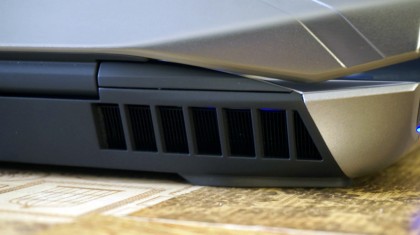TechRadar Verdict
While you can get there for less, this gaming laptop is the express lane to high quality PC gaming.
Pros
- +
Super premium build
- +
Fantastic performance
- +
Bright, vibrant screen
Cons
- -
Expensive
- -
GPU driver/switching issues
Why you can trust TechRadar
Update: We were able to get the gigantic Alienware 17 on video. Check out AlienFX and some games in action on the rig below in our video review.
The 17-inch laptop is a unicorn these days. But in the gaming world, the arguably huge form factor is alive and well. Alienware has doubled down on its colossal clamshell, simply known as the Alienware 17, with an AMD-powered variant.
With an AMD Radeon HD R9 M290X pushing the pixels behind its 1920 x 1080 anti-glare screen, this version of Dell-owned Alienware's notebook comes in $350 (about £207, AU$373) cheaper than its Nvidia-toting counterpart. Given that AMD's latest mobile GPU houses twice as much video RAM – 4GB to the GeForce GTX 860M's 2GB – that's not a bad deal at all.
Aside from that, nothing about the Alienware 17 has changed, including its gigantic frame. Both the MSI GS70 Stealth and Asus G750JX are thinner and cheaper, but fall on different ends of the spectrum in terms of hardware, design and overall focus.
[Editor's note: Since I have yet to test the latest Nvidia GeForce GTX 800M series versions of either of these Asus and MSI machines, I will continue to compare the Alienware 17 to the 700M series editions of these products. This review may be updated after testing MSI, Asus and even Alienware's most current Nvidia-equipped products.]
Design
If you're familiar with Alienware's latest design ID, then none of this will be a shock. But for those coming from the Alienware M17x 2012 perhaps, plenty has changed. The pronounced curvature of the old has given in to a more angular silhouette throughout.
Not only did that make more custom lighting zones a possibility, but it allowed for an all-aluminum lid and magnesium alloy base. This grants the Alienware 17 an even more premium look and feel than before, one that's slightly more subdued – a much welcome change, frankly.
Sign up for breaking news, reviews, opinion, top tech deals, and more.
Alienware says that these and other revisions have increased the system's weight in metal materials considerably, while overall the unit comes in nearly 0.25 pounds lighter. Regardless, this is still a notebook that warrants its own line of custom-made backpacks and shoulder bags.

The keyboard and its lighting received a welcome change as well, moving on from chiclet keys to a more mechanical, switch-based board sitting on an aluminum plate. And in place of the garish, front-facing speaker lights, the entire base is now wrapped in slim, sleek strips of light. Plus, the entire touchpad now illuminates – not just its border.
Flaunting it with AlienFX
Unique to Alienware's laptops is the wide variety of lights that line their chassis and illuminate their keyboards. The company calls this AlienFX, and it returns in full form on the Alienware 17 with incredibly deep customization, thanks to an app of the same name.
AlienFX allows for specific color profiles for each zone of lighting. For instance, if you wanted the Alienware logo and strips of light on the lid in a crimson red, with the lights lining the base shining a cool blue, there's nothing stopping you. Furthermore, four zones of the keyboard can be illuminated in different hues. (And that's not even close to all.)

Digging even deeper, the Alienware 17's lighting scheme can cycle through multiple themes at a certain tempo. And, through the AlienAdrenaline tool, you can create special themes for different games and apps.
The options are nigh limitless, and aesthetically set the Alienware apart from the lot of boutique gaming laptops. More importantly, AlienFX brings a bit of the custom flair of gaming PCs to laptops. Now, let's see what else about the PC gaming experience Alienware manages to emulate.

Joe Osborne is the Senior Technology Editor at Insider Inc. His role is to leads the technology coverage team for the Business Insider Shopping team, facilitating expert reviews, comprehensive buying guides, snap deals news and more. Previously, Joe was TechRadar's US computing editor, leading reviews of everything from gaming PCs to internal components and accessories. In his spare time, Joe is a renowned Dungeons and Dragons dungeon master – and arguably the nicest man in tech.
